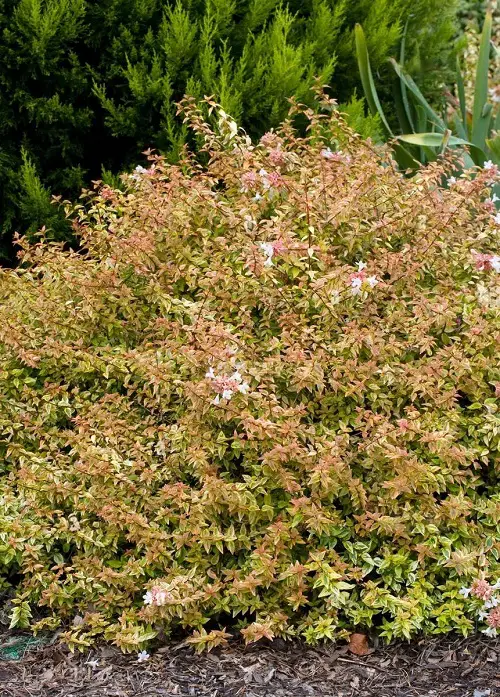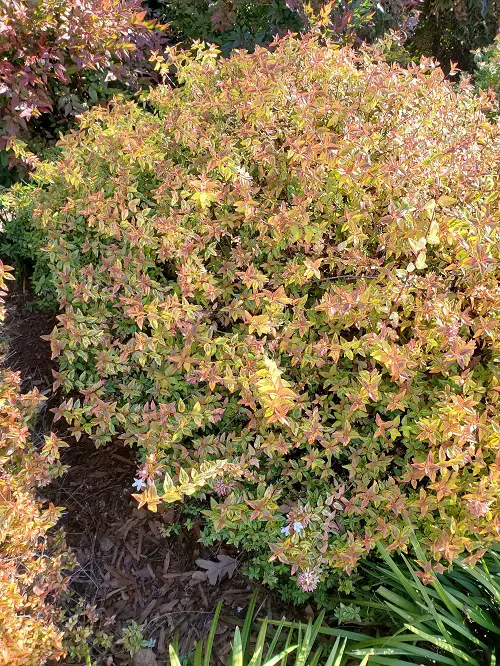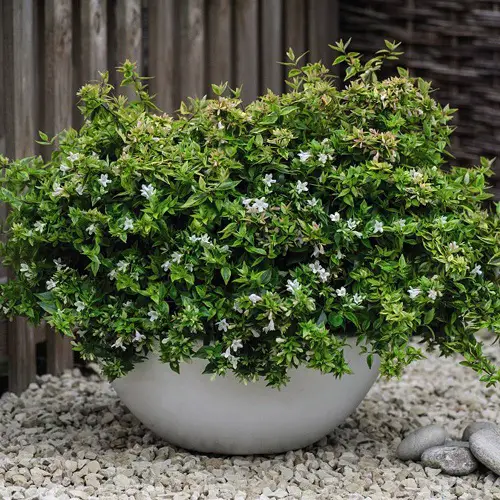Would you like to know How to Grow Kaleidoscope Abelia? Read this detailed guide that contains all the information about it.

This beginner-friendly “How to Grow Kaleidoscope abelia” guide will show you how to nurture and expand the charm of this exquisite plant.
Botanical Name: Abelia × grandiflora ‘Kaleidoscope’
USDA Zones: 6-9
Kaleidoscope abelia Plant Information
The Kaleidoscope abelia is a hybrid ornamental shrub that is cultivated for its variegated foliage and delicate blooms. A member of Abeliaceae family, this plant is a bred by combining various Abelia species to achieve a distinct trait.
This compact shrub displays leaves with a delightful combination of golden yellow, lime green, and fiery red hues. These colors change throughout the seasons, creating a mesmerizing kaleidoscope effect in your garden. Kaleidoscope abelia grows to a height of 3 to 4 feet and spreads up to 4 to 5 feet wide.
In addition to its striking foliage, the plant also produces fragrant white flowers during summer. These delicate blooms not only adds to the beauty but also serves as a valuable nectar source to attract pollinators to the garden.
Propagating Kaleidoscope abelia

Propagating kaleidoscope abelia has various methods, amongst which the semi-hardwood cutting propagation method is the easiest and has been discussed in detail below:
- To begin, you will need to select healthy, vigorous stems from your existing kaleidoscope abelia in late summer or early fall when the new growth has had a chance to become semi-hardwood.
- Using a clean, sharp pruner or knife, cut several 4-6 inch stem sections, making each cut just below a leaf node (the point where leaves emerge from the stem) and removing the soft upper portions along with any flowers or buds.
- Next, remove the lower leaves from the bottom half of each cutting, taking care not to tear the stem bark. You can then dip the ends of the cuttings in a rooting hormone powder or liquid concentrate, which will stimulate root growth, though this step is optional.
- Fill a pot or tray with a sterile soilless potting mix designed for seed starting or cuttings and moisten the mix thoroughly before using a pencil or dibble to make planting holes.
- Carefully insert each prepared cutting roughly halfway into the mix holes, gently firming the mix around the bottom half of each stem. Place the planted cuttings in a warm, bright location but out of direct sun until roots form and new top growth appears, which can take several weeks. During this rooting period, keep the potting mix evenly moist but not saturated, misting the cuttings periodically if needed to maintain humidity levels.
- Once the new kaleidoscope abelia plants have developed a healthy root system, they can be transplanted into individual containers or directly into the ground in a sunny or partially shaded area with well-draining soil amended with compost or manure.
- With proper care and establishment, these propagated plants should grow into lovely flowering shrubs identical to the parent plant.
Growing Kaleidoscope abelia in Pots
Growing Kaleidoscope abelia in pots is a fantastic option for those with limited garden space or for adding vibrant beauty to patios and balconies. Choose a pot that is at least 12-14 inches in diameter to allow sufficient root space for the plant to thrive. Ensure the pot has drainage holes to prevent waterlogging. Use a well-draining potting mix and place the pot in a location with full sun to partial shade.
Regularly water the plant to keep the soil evenly moist, and fertilize it during the growing season to promote healthy growth and abundant blooms. And that’s it; your Kaleidoscope abelia will flourish.
Requirements for Growing Kaleidoscope abelia

Sunlight
Kaleidoscope abelia thrives in locations that receive plenty of sunlight. It performs best when exposed to full sun or partial shade conditions, requiring at least 4-6 hours of direct sunlight daily. While it can tolerate some shade, especially during the hottest part of the day, too much shade can result in poor growth and lack of foliage color.
Soil
This shrub prefers well-draining soil that is rich in organic matter. It can adapt to various soil types, whether loamy, sandy or even clay-based, as long as the soil doesn’t remain waterlogged.
If your soil is heavy clay or drains poorly, amending it with compost or other organic materials can help improve drainage and fertility.
If your soil is heavy clay or poorly draining, you can amend it by adding compost or organic matter to improve drainage and fertility.
Water
Kaleidoscope abelia has moderate water needs and prefers consistently moist soil. Water the plant deeply once or twice a week, adjusting frequency based on weather conditions and soil moisture levels.
During hot and dry spells, you may need to increase the frequency of watering. Applying a layer of organic mulch around the base can help retain soil moisture and suppress weed growth.
Temperature & Humidity
When it comes to temperature and humidity, this shrub can tolerate a wide range of temperatures, from moderately cold winters to hot summers (60°F-85°F). It can also withstand brief periods of frost, but prolonged exposure to freezing temperatures may damage the foliage.
Kaleidoscope abelia Care
Fertilizer
Kaleidoscope abelia benefits from regular fertilization to support healthy growth and vibrant foliage. Apply a balanced, slow-release fertilizer in early spring before new growth begins. Choose a fertilizer with an NPK ratio of around 10-10-10 or similar.
Avoid over-fertilization, as it can lead to excessive leaf growth and reduced flowering.
Pruning
Pruning helps maintain the shape and size of Kaleidoscope abelia, encourages bushier growth, and removes any dead or damaged branches. The best time to prune is in late winter or early spring before new growth starts.
Start by removing any dead or diseased branches and cutting them back to healthy wood. Then, selectively prune to shape the shrub as desired. You can also lightly prune after the main flowering period to remove spent blooms and promote additional flowering.
Pests and Diseases
Kaleidoscope abelia is generally resistant to most pests and diseases. However, it’s still important to monitor the plant for any potential issues. Common pests that may affect abelia include aphids, scale insects, and spider mites.
It may occasionally be susceptible to fungal diseases such as powdery mildew or leaf spot. If you notice signs of fungal infection, such as white powdery patches or dark spots on the leaves, apply a fungicide specifically formulated for the identified disease, following the instructions on the label.




